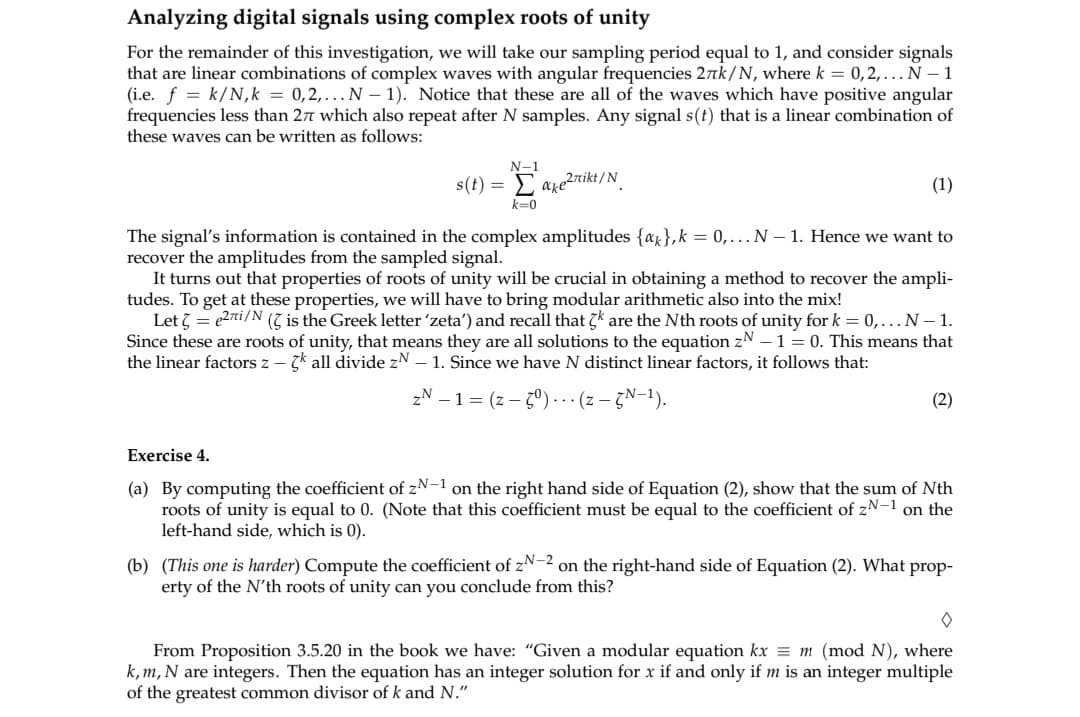(a) By computing the coefficient of zN-1 on the right hand side of Equation (2), show that the sum of Nth roots of unity is equal to 0. (Note that this coefficient must be equal to the coefficient of zN-1 on the left-hand side, which is 0). (b) (This one is harder) Compute the coefficient of zN-2 on the right-hand side of Equation (2). What prop- erty of the N'th roots of unity can you conclude from this?
(a) By computing the coefficient of zN-1 on the right hand side of Equation (2), show that the sum of Nth roots of unity is equal to 0. (Note that this coefficient must be equal to the coefficient of zN-1 on the left-hand side, which is 0). (b) (This one is harder) Compute the coefficient of zN-2 on the right-hand side of Equation (2). What prop- erty of the N'th roots of unity can you conclude from this?
Algebra & Trigonometry with Analytic Geometry
13th Edition
ISBN:9781133382119
Author:Swokowski
Publisher:Swokowski
Chapter10: Sequences, Series, And Probability
Section10.4: Mathematical Induction
Problem 42E
Related questions
Question
Please do Exercise 4 and please do part A and B and please show step by step and explain

Transcribed Image Text:Analyzing digital signals using complex roots of unity
For the remainder of this investigation, we will take our sampling period equal to 1, and consider signals
that are linear combinations of complex waves with angular frequencies 27k/N, where k = 0,2,... N-1
(i.e. f = k/N, k = 0,2,... N-1). Notice that these are all of the waves which have positive angular
frequencies less than 27 which also repeat after N samples. Any signal s(t) that is a linear combination of
these waves can be written as follows:
N-1
s(t) = Σ' ake2nikt/N
k=0
(1)
The signal's information is contained in the complex amplitudes {a}, k = 0,... N-1. Hence we want to
recover the amplitudes from the sampled signal.
It turns out that properties of roots of unity will be crucial in obtaining a method to recover the ampli-
tudes. To get at these properties, we will have to bring modular arithmetic also into the mix!
Let = e27i/N ( is the Greek letter 'zeta') and recall that 5k are the Nth roots of unity for k = 0,... N - 1.
Since these are roots of unity, that means they are all solutions to the equation zN - 1 = 0. This means that
the linear factors z-k all divide zN - 1. Since we have N distinct linear factors, it follows that:
ZN - 1 = (z-5°)... (z - GN-¹).
(2)
Exercise 4.
(a) By computing the coefficient of zN−1 on the right hand side of Equation (2), show that the sum of Nth
roots of unity is equal to 0. (Note that this coefficient must be equal to the coefficient of zN-1 on the
left-hand side, which is 0).
(b) (This one is harder) Compute the coefficient of zN-2 on the right-hand side of Equation (2). What prop-
erty of the N'th roots of unity can you conclude from this?
0
From Proposition 3.5.20 in the book we have: "Given a modular equation kx = m (mod N), where
k, m, N are integers. Then the equation has an integer solution for x if and only if m is an integer multiple
of the greatest common divisor of k and N."
Expert Solution
This question has been solved!
Explore an expertly crafted, step-by-step solution for a thorough understanding of key concepts.
Step by step
Solved in 3 steps with 2 images

Recommended textbooks for you

Algebra & Trigonometry with Analytic Geometry
Algebra
ISBN:
9781133382119
Author:
Swokowski
Publisher:
Cengage

Trigonometry (MindTap Course List)
Trigonometry
ISBN:
9781337278461
Author:
Ron Larson
Publisher:
Cengage Learning

College Algebra
Algebra
ISBN:
9781305115545
Author:
James Stewart, Lothar Redlin, Saleem Watson
Publisher:
Cengage Learning

Algebra & Trigonometry with Analytic Geometry
Algebra
ISBN:
9781133382119
Author:
Swokowski
Publisher:
Cengage

Trigonometry (MindTap Course List)
Trigonometry
ISBN:
9781337278461
Author:
Ron Larson
Publisher:
Cengage Learning

College Algebra
Algebra
ISBN:
9781305115545
Author:
James Stewart, Lothar Redlin, Saleem Watson
Publisher:
Cengage Learning